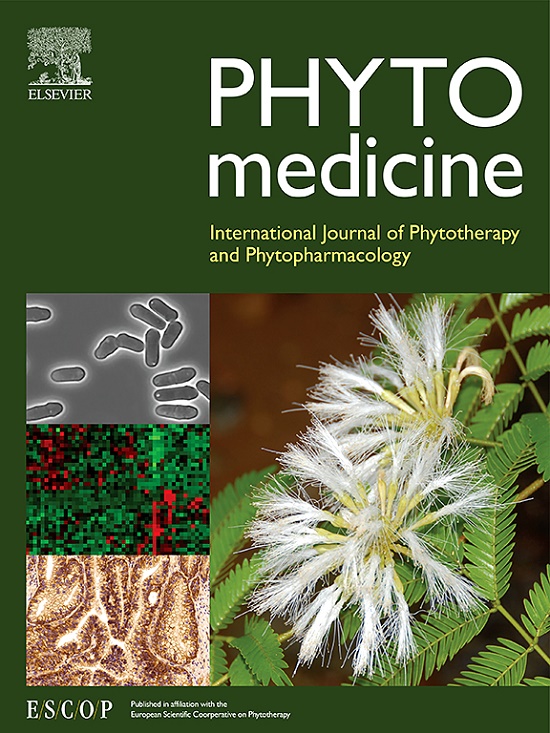Huangqi and Danshen improve the chronic nephrotoxicity of cyclosporin A by regulating lipid metabolism
IF 6.7
1区 医学
Q1 CHEMISTRY, MEDICINAL
引用次数: 0
Abstract
Background
The clinical application of cyclosporine A (CsA) is limited due to nephrotoxicity. Lipid metabolism disorders play important roles in renal injury, but their role in CsA nephrotoxicity is not yet clear. Huangqi (Astragalus mongholicus Bunge) and Danshen (Salvia miltiorrhiza Bunge) (HD) play roles in ameliorating the nephrotoxicity of CsA, but their mechanisms still need to be fully clarified.
Objective
This study innovatively aimed to analyse the coexpression of renal proteins and serum metabolites for the identification of key pathways and targets. This study provides novel insight into the mechanism by which HD ameliorates CsA-induced nephrotoxicity.
Methods
We utilized HD to intervene in both in vivo and in vitro nephrotoxicity models induced by CsA. For the in vivo experiments, we constructed a coexpression network of renal proteins and serum metabolites, which was used to screen for key pathways. To validate these findings, we knocked down key proteins in vivo. For the in vitro studies, we employed MTT, Transwell, flow cytometry, and immunofluorescence assays to monitor the epithelial–mesenchymal transition (EMT) of HK-2 cells. Additionally, we used electron microscopy and Seahorse assays to examine the effects of HD on mitochondrial structure and function. Furthermore, we overexpressed Ppara to further confirm the mechanism by which HD improves renal function.
Results
HD can improve renal pathological damage and function; regulate blood lipids, inflammation and oxidative stress indicators; and reduce apoptosis in renal tissues. Joint protein and metabolomics analyses revealed that two lipid metabolism-related pathways (the PPAR signalling pathway and linoleic acid metabolism pathway) were coenriched, involving six differential proteins (Cyp2e1, Cyp4a10, Gk, Lpl, Ppara, and Pck1) and two differentially abundant metabolites (alpha-Dimorphecolic acid and 12,13-EpOME). Western blot was used to verify differentially expressed proteins. HD improved mitochondrial damage and lipid accumulation, as demonstrated by transmission electron microscopy (TEM) analysis and Oil Red O staining. Knockdown of the key protein Ppara affected the expression of ACOX1 and exacerbated RF. In vitro verification demonstrated that HD significantly inhibited CsA-induced EMT in HK-2 cells and improved mitochondrial structure and function. Ppara overexpression promoted HD-mediated regulation of mitochondrial function, reduced apoptosis, and improved HK-2 RF.
Conclusion
HD can ameliorate CsA nephrotoxicity through renal protein-serum metabolism coexpression, the PPAR signalling pathway, and linoleic acid metabolism. HD-induced upregulation of Ppara to regulate lipid metabolism, improve mitochondrial function and reduce apoptosis are important mechanisms. The Ppara/ACOX1/TGF-β1 axis may play an important role in this process. These findings offer potential targets for the future development of therapeutic strategies and novel drugs.

求助全文
约1分钟内获得全文
求助全文
来源期刊

Phytomedicine
医学-药学
CiteScore
10.30
自引率
5.10%
发文量
670
审稿时长
91 days
期刊介绍:
Phytomedicine is a therapy-oriented journal that publishes innovative studies on the efficacy, safety, quality, and mechanisms of action of specified plant extracts, phytopharmaceuticals, and their isolated constituents. This includes clinical, pharmacological, pharmacokinetic, and toxicological studies of herbal medicinal products, preparations, and purified compounds with defined and consistent quality, ensuring reproducible pharmacological activity. Founded in 1994, Phytomedicine aims to focus and stimulate research in this field and establish internationally accepted scientific standards for pharmacological studies, proof of clinical efficacy, and safety of phytomedicines.
 求助内容:
求助内容: 应助结果提醒方式:
应助结果提醒方式:


